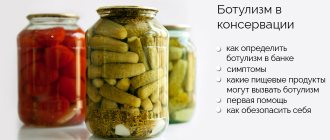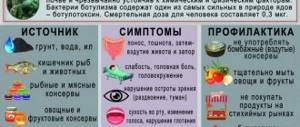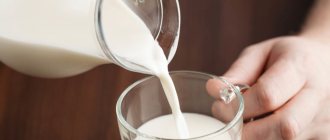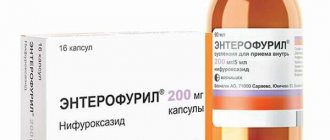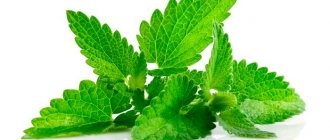Botulism is a disease that belongs to a number of infectious diseases. Damage to the central nervous system occurs due to the penetration of a protein into the body that can cause a disruption in the impulse supply between nerve endings and muscles. As a result, muscle paralysis occurs. The disease is caused by clostridium, an anaerobic bacillus. It lives and reproduces at a temperature of 27–35 degrees.
This toxic substance survives thanks to the released energy provided by nutrients. The condition is the absence of oxygen. If oxygen appears, the substance goes from a vegetative state to a spore state. A special feature is the ability to penetrate into the soil. And from there to vegetables, fruits, water.
Many people are interested in the temperature at which botulism dies. The ability of such pathogens to survive depends on the condition of the environment. The main condition is temperature.
The standard temperature for killing bacteria is 120 degrees.
At this temperature, boiling should be carried out for at least half an hour.
But some types of microorganisms are resistant to such high temperatures. For example, active disease spores survive at high temperatures. And you can get rid of them after a long period of time in the autoclave, where the boiling process takes place. When canning food, it is not enough to simply bring the water temperature to a boil to get rid of toxins. It must be boiled for at least 30 minutes. This is explained by the fact that even tap water can contain a source of botulism.
BACILLUS
- A bacillus or rod (lat. bacilli, singular bacillum or bacillus - “stick”) is a rod-shaped bacterium capable of forming spores, in contrast to non-spore-bearing bacteria.
- Another name for bacteria
- Rod-shaped bacteria
- A rod-shaped bacterium
- Pathogenic bacteria
- Rod-shaped bacteria, including
, for example, those that cause tetanus, anthrax - Microbe, coccus, bacterium
- Bacterium
- Malicious bacteria
- Rod bacterium
- Infectious stick
How to Destroy Botulism Toxins
Both adults and children can become infected with botulism. It is not the bacterium that poses a health hazard, but the toxins it produces.
They can be destroyed by boiling, which lasts 25 minutes. Botulism is killed when temperatures reach 60 degrees, but the toxicity will remain for 2-3 hours. At 80 degrees it takes half an hour. If the product contains a large amount of fat mass, then it is more difficult to destroy the toxin. To protect yourself from this disease, you should remember a number of conditions in which the life activity and process of reproduction of botulism bacteria is impossible. Such conditions include:
- Microbes cannot withstand a sugar environment. You can safely consume jam, preserves, compote, which have been thoroughly boiled during the preparation period. The container should not be tightly closed so that air cannot get in.
- Acidic environment. It has a detrimental effect on microorganisms. During the boiling process, add citric acid, vinegar, and lemon juice. Bacteria do not live in an acidic environment.
- Use of mustard in cooking.
- Food that is vacuum packed is safe. The degree of their humidity is reduced to a minimum.
- At what temperature does botulism in meat die? Meat products must be processed at a temperature of 110 degrees. There is no other method to kill bacteria in meat. It is recommended to boil the meat product for another 20 minutes. This can eliminate the risk of contracting botulism.
- Concentrated saline solution. Used in preserving cucumbers. Cucumbers pickled in a bucket or barrel can be consumed without fear. They become salty in an environment where there is oxygen.
There is a misconception that botulism toxin can be destroyed by low temperature.
Botulism bacilli, which are the causative agents of the disease, have the ability to survive in temperatures that reach significantly low levels. At the same time, toxic substances continue to be released.
It has been scientifically proven that the spore form of botulism could survive even at minus 195 degrees. It follows that there is no point in trying to kill bacteria in a home freezer, the temperature of which does not fall below 15 degrees.
How to protect yourself
Botulism is a disease that cannot be treated on your own. Most of the victims were poisoned as a result of consuming home-made canned goods. Canned products affected by botulism cannot be visually determined. The toxic substance does not cause taste or color changes. Precautions must be carefully observed:
- Do not preserve mushrooms, fish, meat and herbs.
- If the jar swells, it should be thrown away.
- Before preservation, lids and jars are sterilized. If the lid is made of tin, it is boiled.
- Wash the products thoroughly. Dirt is washed off with a brush.
- Store sausage, salted fish, and lard in the refrigerator, the temperature in which should not rise above 8 degrees. Such products are not processed at high temperatures.
- If the vegetables and fruits that you planned to preserve are in poor condition (spoiled, rotten, unripe, stale), you should cancel the process.
- Do not purchase sealed mushrooms from an unverified seller.
- If a person in the family becomes ill with botulism, the rest of the family members are recommended to be observed by a local doctor for about two weeks. And also disinfect clothes, dishes and household items used by the victim.
If all of the above is observed, a person will be able to avoid becoming infected with botulism.
BARREL
- A barrel is a cylindrical or other shaped vessel that can be rolled (unlike a tub) from one place to another and placed on its ends without additional supports, intended for transporting and storing liquid and other substances.
- In Russian stone and wooden architecture of the 17th-18th centuries. roof in the shape of a half-cylinder with a raised and pointed top, forming a keel-shaped pediment on the façade
- Cylindrical or conical gold washing device
Bioresonance - a new method in medicine
One of the new trends in medicine is bioresonance therapy. The method is based on the idea of any living object as a source of electromagnetic vibrations. Any pathology of the body is accompanied by impaired bioresonance, which is revealed during examination of the patient.
The method has high efficiency and a wide range of applications. Exposure to bioresonance allows you to restore normal wave parameters of each individual organ and the body as a whole, leading to the death of pathogenic bacteria, and the error of the method is minimal.
Yulia Pyatirubleva
DISCUSSION
- The nuclear energy debate is a debate about the introduction and use of nuclear reactors for peaceful purposes to produce electricity from nuclear fuel.
- Public dispute, discussion of any issue orally or in print
- Dispute, discussion of some issue at a meeting, in the press, in conversation
- Dispute, discussion, debate
- Dispute, discussion of an issue
- Dispute at a meeting
- Dispute at the meeting
- An attempt to find out the truth in a dispute
- Discussion of a controversial issue
Prevention of infection
Once infected, the patient needs urgent treatment in a hospital setting. Recovery will occur rather slowly - you should not count on full recovery faster than in a month. Vaccination is ineffective because it only provides temporary protection. Therefore, special attention should be paid to preventive measures. The resistance of botulism spores and bacilli to various influences is high, but there are ways to destroy the pathogen:
creating an acidic environment with further boiling kills the bacteria;- pickles in a barrel are completely safe - bacteria cannot grow in them;
- no botulism was observed in jam or syrup with a sugar concentration of about 50%;
- freeze-dried products with minimal humidity cannot be a source of infection;
- mustard is the best remedy to fight bacteria.
In the process of home canning, special attention should be paid to sterilization of the product and container. Not the slightest particle of soil should remain on vegetables and mushrooms. And also do not experiment with recipes - do not reduce the dosage of salt and vinegar!
Reproduction of bacteria and formation of spores
Like other single-celled organisms, bacteria reproduce by division. Each bacterium divides into two daughter bacteria, which quickly grow and divide again. Under favorable conditions, cell division in many bacteria can occur every \(20\)–\(30\) minutes. With such rapid reproduction, one bacterium could produce offspring with a total mass of \( 1\)\(800\) \(000\) kg, and the offspring of one bacterium in \(5\) days could fill all the seas and oceans on Earth!
However, this does not happen in nature, since most bacteria quickly die under the influence of sunlight, drying, lack of food, heating to \(65\)–\(100\) °C, under the influence of disinfectants, etc.B Under unfavorable conditions (with a lack of food, moisture, sudden changes in temperature), the cytoplasm of the bacterial cell, shrinking, moves away from the mother shell, becomes rounded and forms a new, denser shell inside it on its surface. Such a bacterial cell is called a spore (from the Greek word “spore” - seed).
Spores of some bacteria persist for a very long time in the most unfavorable conditions. They can withstand drying, heat and frost, and do not immediately die even in boiling water. Spores are easily spread by wind, water, etc.
d. There are many of them in the air and soil. Under favorable conditions, the spore germinates and becomes a living bacterium. Bacterial spores are an adaptation to survival in unfavorable conditions. Pasechnik V.V. Biology. 5th grade // Bustard.Ponomareva I.N., Kornilova O.A., Kuchmenko V.S. Biology. 6th grade // IC VENTANA-GRAF. Viktorov V. P., Nikishov A. I. Biology. Plants. Bacteria. Fungi and lichens. 7th grade // Humanitarian publishing .https://biouroki.ru/material/plants/bakterii.htmlhttps://lib2.podelise.ru/docs/934/index-130905.html
Botulism stamps that survive at 120 degrees
The botulism bacillus can be located in the soil, the body of pets, home preserves, dried meat, and dry fish. Medicine knows 7 stamps of the causative agent of the disease, which differ in structure, survival, conditions, and toxins released:
- A.
- IN.
- C, subspecies: C1, C2.
- D.
- E.
- F.
- G.
Medical literature describes that heat treatment at 120°C under a pressure of at least 2.0 kgf/sq cm for up to 6 hours destroys toxins under any conditions and completely kills all types of botulism pathogens.
The article was approved by the editors
Important point
Over the past twenty years, food canning techniques in particular and food preparation in general have changed quite significantly. This happened thanks to the active development of science in all sectors and the increasing introduction of high technologies into all spheres of life. Therefore, when canning at home, you need to focus on the latest developments in this area, and not on old recipes.
At the same time, you need to know that even information posted on the Internet is not always up-to-date. It may simply be reprinted from an old book. You need to find out the source or ask the author himself; if this is not possible, do not rely on this recipe. Even what was previously considered obvious and beyond doubt can now be refuted. Some points regarding home canned food, used in the last century, now do not stand up to criticism, since they do not take into account new knowledge in this area. Given the high risk of contracting botulism, this point should always be remembered.
At what temperature and humidity does the flu die?
The virus loves humidity and warm air, the temperature of which tends to zero. Therefore, in Asian countries, influenza disease occurs on a par with such dangerous tropical diseases as malaria, cholera, and typhoid fever. In these regions, influenza is especially dangerous, since the virus has great contact with animals, in whose bodies it mutates and acquires new pathogenic properties and becomes more aggressive towards the microorganism.
The first disease pandemics of the 20th century were recorded in Hong Kong. There is a particularly high population density and therefore the virions spread very quickly among people and caused the death of more than 40 thousand people. But in African countries, where there is a drier climate, influenza infection is much less common.
Does the flu virus die in a sauna, and at what temperature?
In deep villages, a sauna is used to prevent and treat viral infections. There you can cure sore joints, a sore throat, improve blood supply to all organs, and all this in good company, accompanied by sincere conversations with a mug of tea and healing honey. A sauna is one of the best methods for preventing influenza infection in winter.
Dry and hot air perfectly kills the virus, destroying its protective shell. Also, the sauna is an excellent means of combating colds of viral etiology at the very beginning of the disease. Upon contact with a person who has the flu, viral particles often move to the surface of the mucous membranes of the respiratory system of a healthy person.
Dry and hot sauna air destroys the shell of the influenza virus

